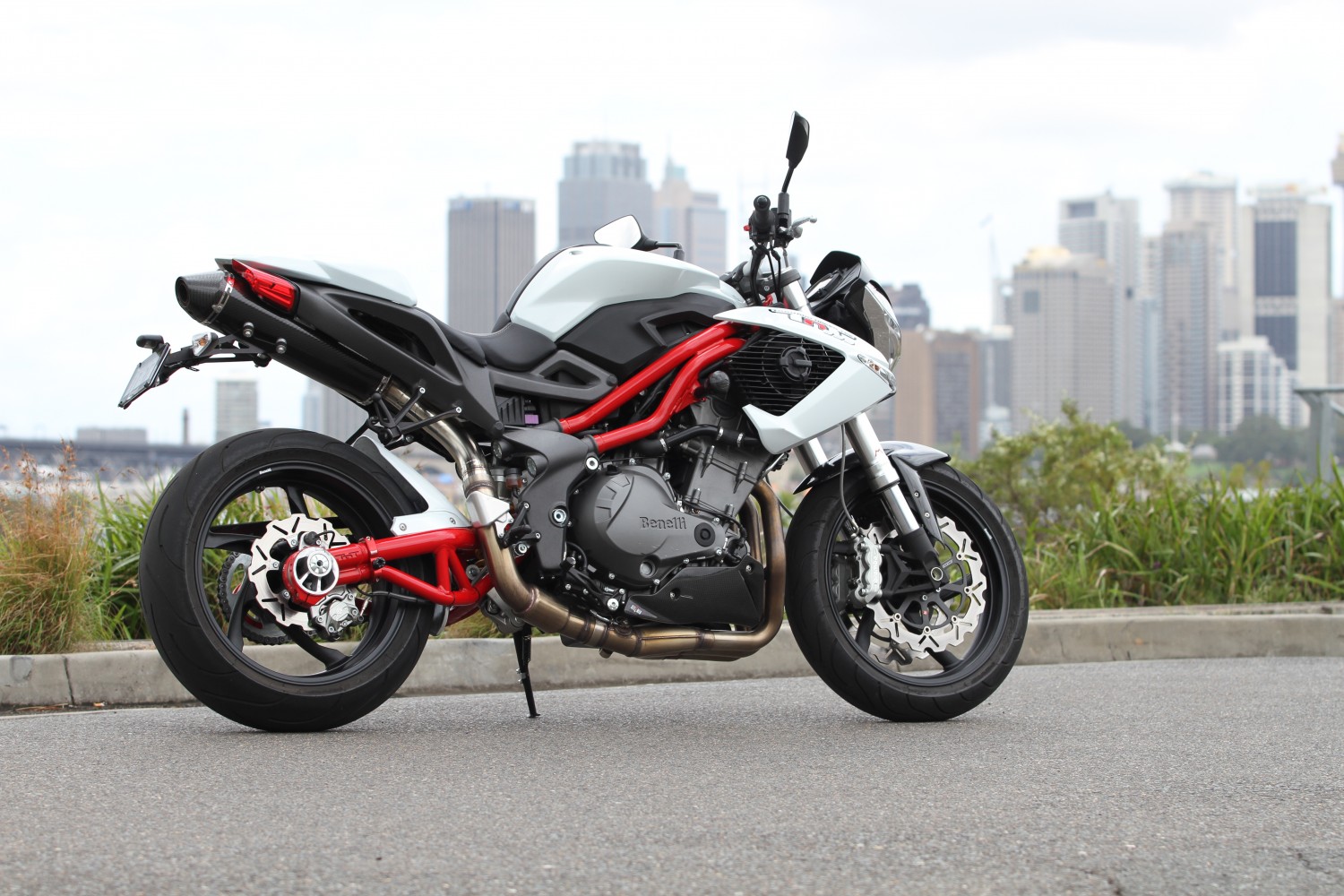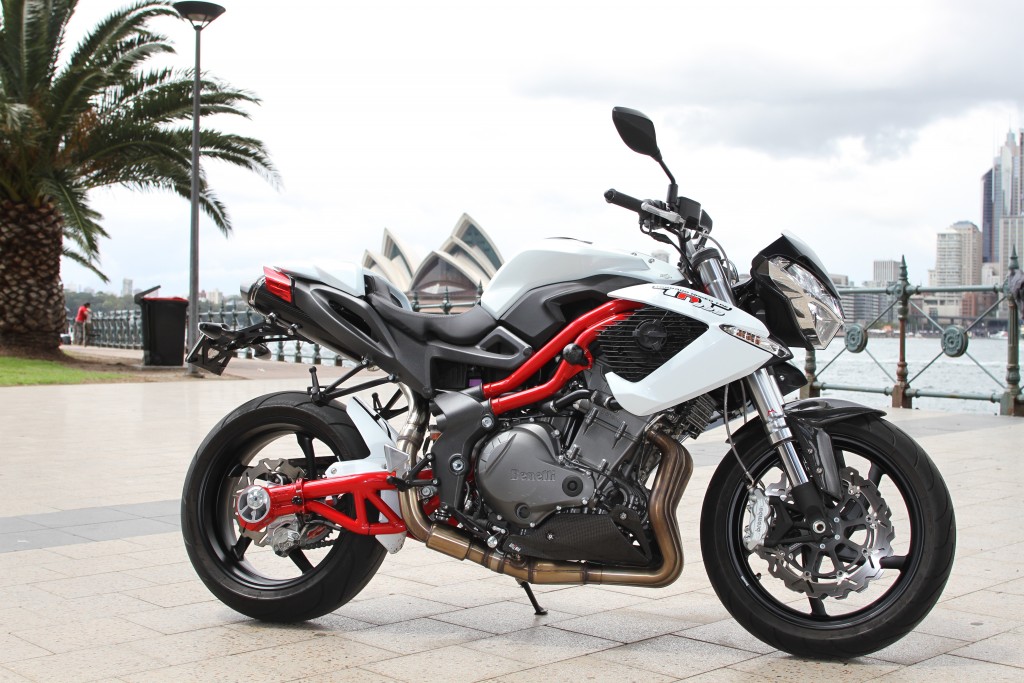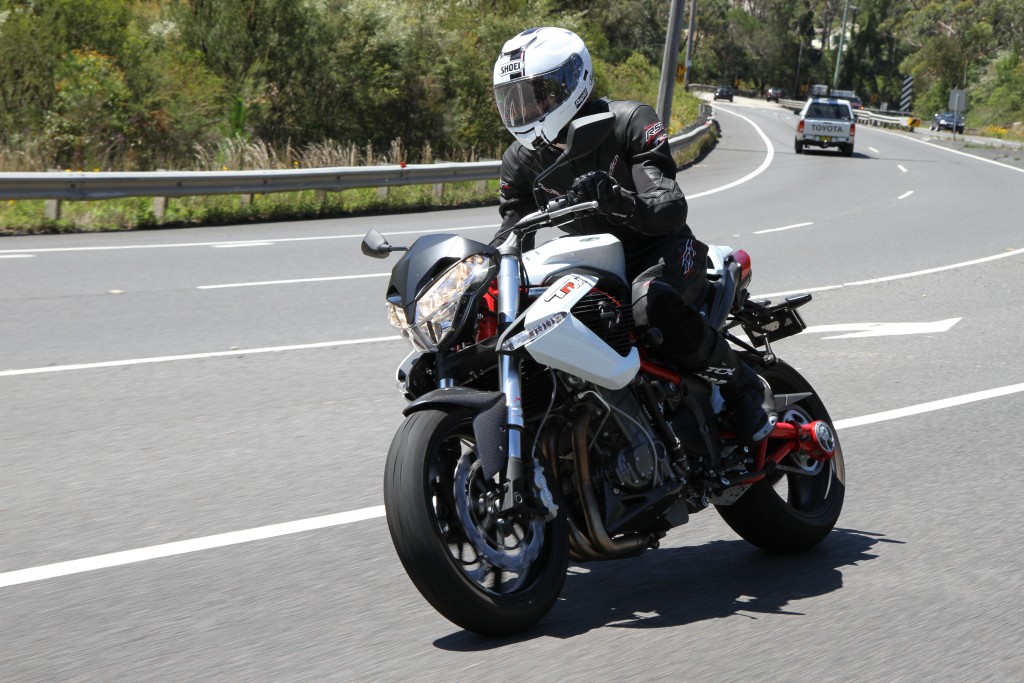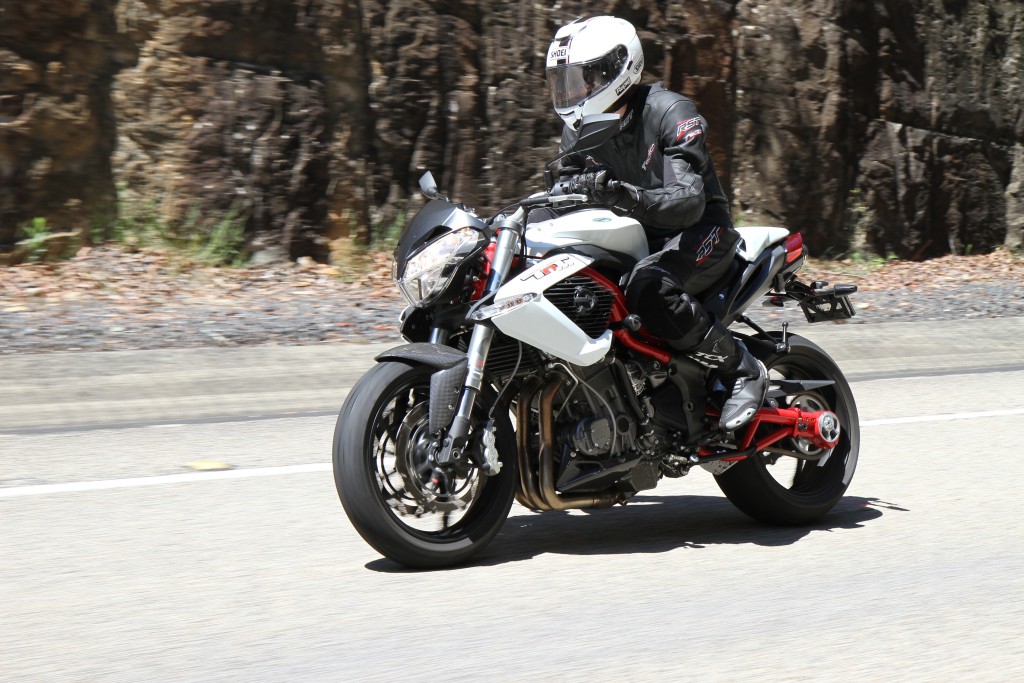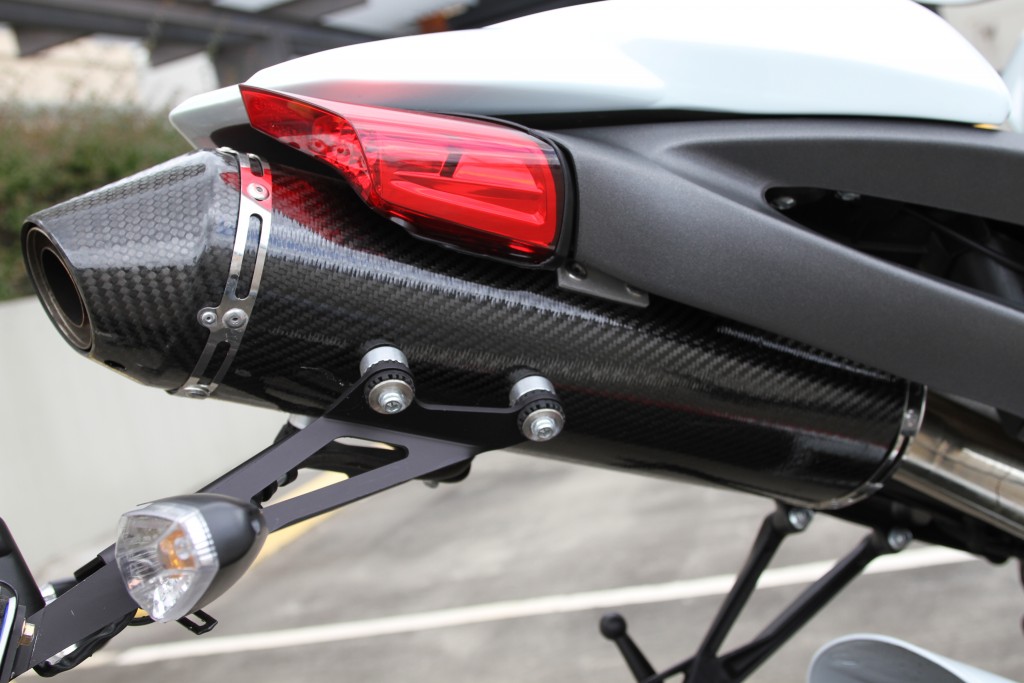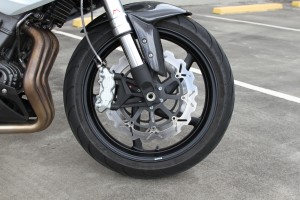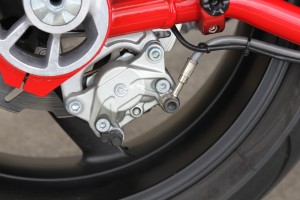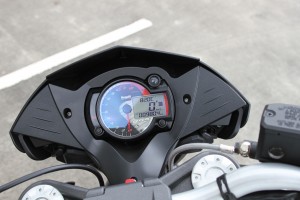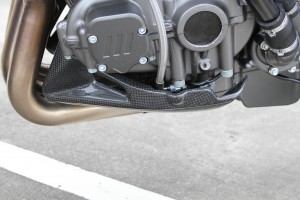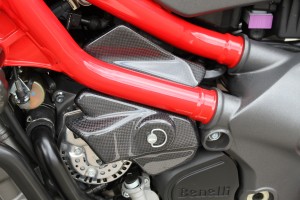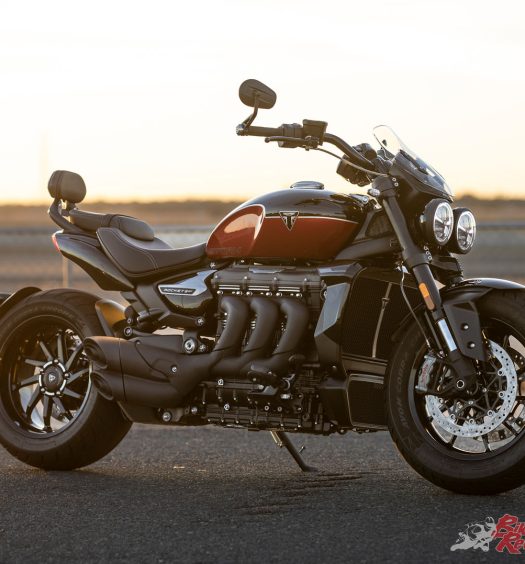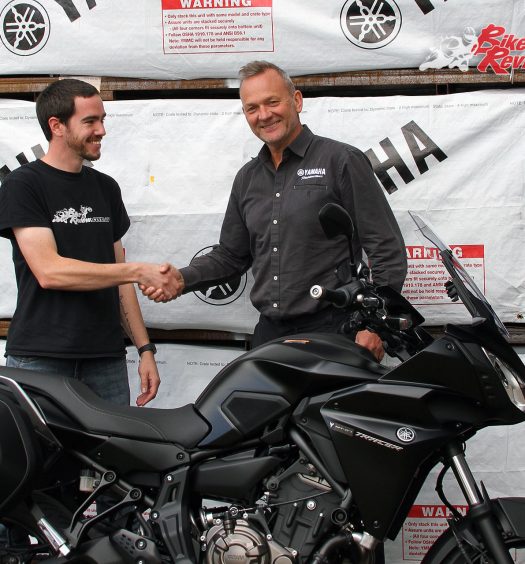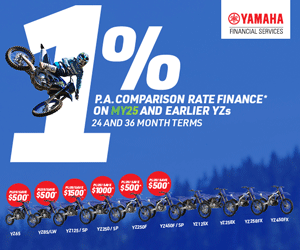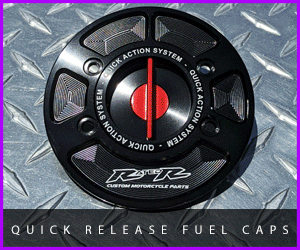Benelli's TnT 899 is a well spec'd and exciting middle-weight triple-cylinder offering... Here's our Benelli TNT 899 review. Test: Kris Hodgson Photography: Heather Ware
When the news hit that we would be testing out a Benelli TnT 899 I have to admit a massive smile split my face, particularly as only Jeff and I were present, meaning I got dibs uncontested, with Jeff’s cries lost behind the massive piles of work surrounding him.
As an owner of a triple and having been mightily impressed by the various triple-cylindered offerings throughout the year I have to admit the idea of the Benelli was very attractive, especially considering it combines another of my favourite bike attributes – being a nakedbike. I was soon on my way to D Moto, an authourised Benelli repairer in Clyde (NSW) – where I was to pick up the bike from Shaun and George.
With pleasantries exchanged and a few details shared (clutch in to start the bike, 95 octane only) I jumped on board the 899 and set off into typical 5:00pm traffic. I always find heavy traffic a great point of reference when I test a bike, as it is often an area that highlights fuelling, cooling and ergonomic issues at a crawl, while also revealing whether a bike would be ideal for everyday riding, or as more of a weekend scratcher.
The Benelli TnT 899 On The Road
It may not be the most fun part of a test but chances are you’ll encounter this kind of traffic more often than you’d like and the Benelli 899 proved very accomplished.
With an upright seating position on the firm seat, good reach to wide bars and relatively low pegs providing comfortable leg positioning, the bike was immediately comfortable. Controls are easy and at hand, without any of the surprises that some bikes offer when a manufacturer decides to swap buttons for whatever reason. A pleasant addition was also the hazard light switch, which while thankfully unnecessary has proven useful in my previous experiences.
The dash was also simple and easy to read incorporating a digital speedo with analogue tacho.
Heading down Parramatta road the bike responds to throttle input well, with relatively tall gearing.
Balance is exemplary and with the upright seating position it’s easy to crawl along even in the heaviest of traffic without needing to constantly drag a foot or use continuous clutch feathering.The tall gears encourage you to rev that bit harder before shifting which can lead to a little throttle snatch if you stay in first for too long and aren’t careful with the throttle.
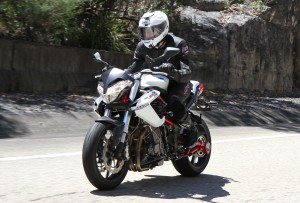 Generally however at any reasonable speed you don’t find the hesitation or light-switch behaviour that some bikes suffer from, with smooth delivery and a good transition to engine braking.
Generally however at any reasonable speed you don’t find the hesitation or light-switch behaviour that some bikes suffer from, with smooth delivery and a good transition to engine braking.
The bike’s agility also becomes immediately obvious once moving with lots of control available – even at low speeds – for avoiding obstacles, filtering or just quick changes of direction or lane.
At a standstill the bike’s heavier and top heavy nature isn’t so great if you are just moving it around your garage which is unsurprising with a dry weight around the 203kg mark. However it’s only really when moving that it’s worth making weight an issue and the 899 certainly isn’t tardy in this area.
The carbon-fibre exhaust (an optional accessory) sends the triple burble spilling out and while I wouldn’t want to be pulled up by the police with the bike running, it certainly gives the bike some very audible character, drawing attention and stares from passing road users. There’s something very unique about that triple burble particularly on deceleration that gets the blood flowing.
Where the 899 is a viable and fun commuter, its true strength is out on the open road where you have the room to really stretch the bike’s metaphoric legs.The tall gearing means you could be forgiven for assuming you’ve already reached top gear while sitting in just fourth on the highway, while hooning through the twisties in second or third and really wringing the bike’s neck provides great thrills.
In fact in sixth gear you’ll be cruising at just 5000rpm at 120km/h indicated.
The gearbox and clutch are not light, but changing gears is definitive, with good engagement. Coming from some bikes it may seem somewhat clunky but it’s really just a matter of what you are used to, with everything working well and inspiring confidence.
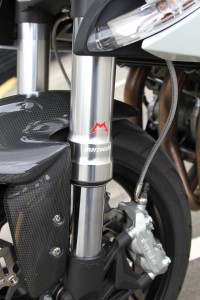 The suspension remains ideal on the open road, combining good absorption on poor road surfaces, while still remaining relatively sporty, if a little on the soft side as it was adjusted from the workshop on pickup for my 70kg weight.The Marzocchi 50mm USD forks felt sporty in normal conditions, while the rear suspension transferred only the biggest of bumps in a jarring manner. The bike also responded best to light rear braking through corners to help stabilise the bike.
The suspension remains ideal on the open road, combining good absorption on poor road surfaces, while still remaining relatively sporty, if a little on the soft side as it was adjusted from the workshop on pickup for my 70kg weight.The Marzocchi 50mm USD forks felt sporty in normal conditions, while the rear suspension transferred only the biggest of bumps in a jarring manner. The bike also responded best to light rear braking through corners to help stabilise the bike.
The suspension did see-saw slightly as weight transferred between the front Marzocchi forks and the rear Sachs shock, although adjustment to suit one’s specific weight and needs would certainly help if not solve this issue. The rear Sachs shock is both preload and rebound adjustable, unlike the forks.
Pulling the bike back from high speeds the Brembo calipers started off formidably, with the rear showing particular bite but after 1000km of hard use the bite in the front brakes had faded considerably. Stopping power was still good but feel through the lever was reduced slightly and that initial bite was noticeably reduced. Wavey Braking rotors are also a nice touch, fitting the bike’s aggressive styling and theme.
The engine itself is a joy at higher speeds, encouraging you to really rev the bike rather than upshifting, with the rpm seeming to rise far too slowly in comparison to your speed, not that it is an issue – just an observation. This creates the impression that the bike can just keep accelerating despite a redline that is only just past 11000rpm.
The engine is also very happy transferring on and off the power, as well as maintaining a set speed – a trait which some of the more exotic European options can struggle with, due to throttle sensitivity, particularly on Australian roads with more than our fair share of bumps and inconsistencies. The 899 however will cruise happily at legal, or not so legal speeds from fourth to sixth gear on the highway, settling into a good rhythm if you are out for a more relaxed ride.
The real fun is to be had from pushing the triple engine hard and taking advantage of the motard like handling and ergonomics which really lend themselves to hooning. The bike wont hold a line as effortlessly as a pure sportsbike but more than holds its own thanks to the pure ease of fanging it around, with the easy transfer of weight through the pegs and wide bars. It also proved of the perfect dimensions for locking my legs in between the pegs and underneath the tank for even more control and confidence. Grip remains good throughout although the front wheel lightens almost imperceptibly as you push harder, taking away from the sense of confidence ever so slightly.
The one real downside to this amazing engine turned out to be fuel consumption, with the bike guzzling around 12 litres per 150-160km, although it was received with just 500km on the clock and ridden hard. Whether the accessorised carbon-fibre exhaust effects the running of the bike was unfortunately an area we didn’t have time to explore during our too short period with the bike but it was running noticeably rich.
The bike’s styling is of course quite unique and is a nice change of pace from the plethora of bikes now offered in relatively expectable forms, with a standard level of bling incorporating carbon-fibre and a stunning red trestle steel frame, external cast sub-frame and red swing-arm to match the frame.
Side-mounted radiators including fans are particularly eye catching and do a great job of keeping the bike cool even in the hottest of weather, including temperatures in the high 30s, with the radiator guards incorporating aggressive highly visible indicators. You’ll probably love or hate this feature, but if this was my bike I’d look at the viability of having the outer fan grill painted to match the frame and swingarm for some extra visual punch.
A further eye catching, if partially hidden, feature is the wheels, which are a twisted five-spoke affair clad in Michelin rubber. The tank consists of two outer painted pieces while the centre strip containing the fuel cap is plastic, with slight inconsistencies visible in the finish of the plastic surrounding the fuel cap of the model tested – something sure to annoy those who expect their bike to fulfil both display piece and transport but less of an issue for those who just wish to ride the wheels off the thing! It’s certainly not a detail that would effect purchasing one for me.
Just below the tank are also molded side panels, with the airbox visible just above the frame.
Both the seat and tail are aggressively styled and minimalistic, with the single seat featuring visible stitching and a raised section that integrates into the tail. The tail itself looks like something from a jet with (fake) intake ducts thanks to the seat cowl and the very small taillights throw an astonishing amount of light for their size. The carbon-fibre underseat exhaust is also an improvement visually on the stock offering and no doubt considerably louder.
The crash bobbins or chassis pad kit as Benelli calls them and the rear stand supports are all also welcome additions that would certainly be appreciated by any owner and are a good investment.
On the front end the headlight is an interesting, aggressive, double stacked affair that provides really good reach and vision, with a very insect like theme to the design. You would also be forgiven for thinking the mirrors have been connected to the stems upside down in another interesting move that is certainly more stylish than many of the stock mirrors seen these days, without affecting the level of vision available.
Overall the entire package is pretty suave and really stands out in the naked crowd for going its own way, with high-end components, great build quality and plenty of performance. As triples become increasingly popular for the useability across a variety of applications, I can’t help but think that Benelli’s TnT 899 is yet another example of exactly why people are making the switch!
SPECIFICATIONS
2014 Benelli TnT 899
benelli.com.au
PRICE: $15,590 + ORC
WARRANTY: Two year/unlimited kilometre
COLOURS: White (red frame)
CLAIMED POWER: 89kw[121hp]@9500rpm
CLAIMED TORQUE: 88Nm[65ft-lbs]@8000rpm
DRY WEIGHT: 203kg
FUEL CAPACITY: 16L
ENGINE: Liquid-cooled, 12-valve, in-line triple-cylinder, 899cc, 88 x 49mm bore x stroke, 12.5:1 compression, EFI, 53mm throttle-bodies
GEARBOX: Six-speed
CLUTCH: Wet clutch
CHASSIS: Trestle steel frame, adjoining rear aluminium alloy cast sub-frame
WHEELBASE: 1443mm
SUSPENSION: Marzocchi 50mm USD forks, Sachs shock, adjustable preload and rebound, 120mm travel
BRAKES: Dual floating front 320mm Braking wavey rotors, Brembo four-piston radial mount calipers, 240mm rear Braking wavey rotor, Brembo twin-piston caliper
WHEELS & TYRES: Aluminium alloy wheels, 120/70-17(120/65-17), 190/50-17(180/55-17), Michelin Pilot Powers
DIMENSIONS: Seat height: 830mm, Overall height: 1050mm, Overall length: 2100mm
INSTRUMENTS: Digital speedo and display, analogue tachometer
Review: 2013 Benelli TnT 899


